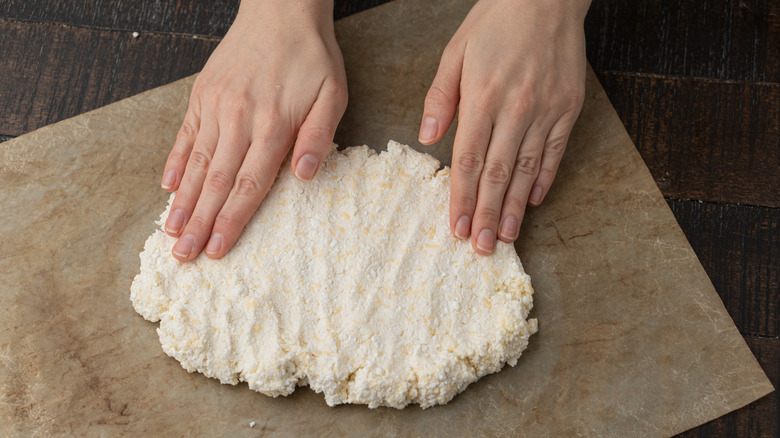The High-Protein Pizza Crust That Only Requires 2 Ingredients
Protein isn't just for gym gains. It's an essential macronutrient that protects against age-related muscle loss, which can begin as early as your 30s. Even for younger people, protein is still necessary for skin, bone, muscle, and digestive maintenance. Despite its key role in maintaining health, many fall short of their daily needs. The recommended dietary allowance of protein is about 0.36 grams per pound of body weight, and experts at Harvard University say that up to 25% of adults in the United States aren't meeting this requirement, necessitating a search for high-protein foods that can be easily integrated into a well-balanced diet without compromising on flavor. While pizza isn't exactly synonymous with a high-protein diet, you can boost its protein value with an easy-to-make two-ingredient crust starring cottage cheese and flour.
As a high-protein dairy product with a mild-mannered flavor that doesn't overpower other ingredients, cottage cheese is the perfect companion for blending with flour to roll out into a pizza crust. Just 1 cup of cottage cheese contains 28 grams of protein. In comparison, that's more protein than a standard 3-ounce serving of top sirloin steak – one of the highest protein cuts of beef. You don't need to be a seasoned pizzaiolo to make this no-frills pizza crust, either. Simply knead together cottage cheese with flour, roll it out, and bake — et voilà — a perfectly crispy, high-protein pizza crust that browns around the edges and holds up to your favorite toppings.
Tips for making a high-protein pizza crust with cottage cheese
A cottage cheese pizza crust is accessible to make and doesn't require Michelin-star skills to perfect. However, it's helpful to keep a few tips in mind to ensure a sturdy, evenly-textured, and overall well-made pizza crust.
Because cottage cheese is a high-moisture dairy product with a dense consistency, self-rising flour is essential for this pizza crust, as it contains leavening agents for a lighter, more structured pie foundation that rises like a yeast-infused dough. Alternatively, you can also transform all-purpose flour into self-rising flour by introducing a small amount of salt and baking powder. No matter what, make sure to drain excess moisture from the cottage cheese before combining it with your flour. Although you will eventually smooth it out, if you have an aversion to the curd-like texture of cottage cheese, you can blend it before combining it with flour.
A reliable ratio for making the crust is a cup of cottage cheese to 1½ or 1¾ cups of self-rising flour for a 12-inch pizza. Of course, you'll need to increase or reduce your measurements depending on your desired pizza size. Once you've kneaded your two-ingredient dough, adding any dried herbs or seasonings for extra flavor, roll out and pre-bake the dough for five minutes at around 450 degrees Fahrenheit before removing it to add your favorite sauce, cheese, and protein-heavy toppings and baking until done.
Meeting the recommended dietary allowance of protein can be a challenge, but it doesn't have to all be roasted chicken dinners and the same seared meats as last week. Think outside of the box and infuse your pizza crust with a deceptively hearty cottage cheese protein upgrade.

